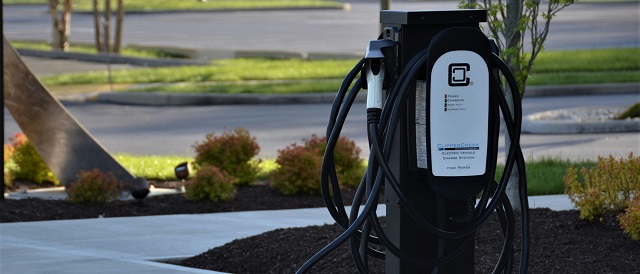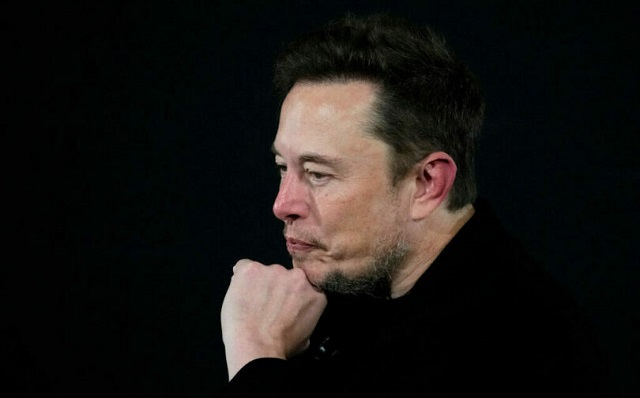Automotive
The EV ‘Bloodbath’ Arrives Early

 From the Daily Caller News Foundation
From the Daily Caller News Foundation
By David Blackmon
Ever since March 16, when presidential candidate Donald Trump created a controversy by predicting President Joe Biden’s efforts to force Americans to convert their lives to electric-vehicle (EV) lifestyles would end in a “bloodbath” for the U.S. auto industry, the industry’s own disastrous results have consistently proven him accurate.
The latest example came this week when Ford Motor Company reported that it had somehow managed to lose $132,000 per unit sold during Q1 2024 in its Model e EV division. The disastrous first quarter results follow the equally disastrous results for 2023, when the company said it lost $4.7 billion in Model e for the full 12-month period.
While the company has remained profitable overall thanks to strong demand for its legacy internal combustion SUV, pickup, and heavy vehicle models, the string of major losses in its EV line led the company to announce a shift in strategic vision in early April. Ford CEO Jim Farley said then that the company would delay the introduction of additional planned all-electric models and scale back production of current models like the F-150 Lightning pickup while refocusing efforts on introducing new hybrid models across its business line.
General Motors reported it had good overall Q1 results, but they were based on strong sales of its gas-powered SUV and truck models, not its EVs. GM is so gun-shy about reporting EV-specific results that it doesn’t break them out in its quarterly reports, so there is no way of knowing what the real bottom line amounts to from that part of the business. This is possibly a practice Ford should consider adopting.
After reporting its own disappointing Q1 results in which adjusted earnings collapsed by 48% and deliveries dropped by 20% from the previous quarter, Tesla announced it is laying off 10 percent of its global workforce, including 2,688 employees at its Austin plant, where its vaunted Cybertruck is manufactured. Since its introduction in November, the Cybertruck has been beset by buyer complaints ranging from breakdowns within minutes after taking delivery, to its $3,000 camping tent feature failing to deploy, to an incident in which one buyer complained his vehicle shut down for 5 hours after he failed to put the truck in “carwash mode” before running it through a local car wash.
Meanwhile, international auto rental company Hertz is now fire selling its own fleet of Teslas and other EV models in its efforts to salvage a little final value from what is turning out to be a disastrous EV gamble. In a giant fit of green virtue-signaling, the company invested whole hog into the Biden subsidy program in 2021 with a mass purchase of as many as 100,000 Teslas and 50,000 Polestar models, only to find that customer demand for renting electric cars was as tepid as demand to buy them outright. For its troubles, Hertz reported it had lost $392 million during Q1, attributing $195 million of the loss to its EV struggles. Hertz’s share price plummeted by about 20% on April 25, and was down by 55% for the year.
If all this financial carnage does not yet constitute a “bloodbath” for the U.S. EV sector, it is difficult to imagine what would. But wait: It really isn’t all that hard to imagine at all, is it? When he used that term back in March, Trump was referring not just to the ruinous Biden subsidy program, but also to plans by China to establish an EV-manufacturing beachhead in Mexico, from which it would be able to flood the U.S. market with its cheap but high-quality electric models. That would definitely cause an already disastrous domestic EV market to get even worse, wouldn’t it?
The bottom line here is that it is becoming obvious even to ardent EV fans that US consumer demand for EVs has reached a peak long before the industry and government expected it would.
It’s a bit of a perfect storm, one that rent-seeking company executives and obliging policymakers brought upon themselves. Given that this outcome was highly predictable, with so many warning that it was in fact inevitable, a reckoning from investors and corporate boards and voters will soon come due. It could become a bloodbath of its own, and perhaps it should.
David Blackmon is an energy writer and consultant based in Texas. He spent 40 years in the oil and gas business, where he specialized in public policy and communications.
Automotive
Electric vehicle mandates mean misery all around

From the Fraser Institute
By Matthew Lau
The latest news of slowing demand for electric vehicles highlight the profound hazards of the federal government’s Soviet-style mandate that 100 per cent of new light-duty vehicles sold must be electric or plug-in hybrid by 2035 (with interim targets of 20 per cent by 2026 and 60 per cent by 2030, with steep penalties for dealers missing these targets).
The targets were wild to begin with—as Manhattan Institute senior fellow Mark P. Mills observed, bans on conventional vehicles and mandated switches to electric mean, in jurisdictions such as Canada, “consumers will need to adopt EVs at a scale and velocity 10 times greater and faster than the introduction of any new model of car in history.”
Indeed, when the Trudeau government announced its mandate last December, conventional vehicles accounted for 87 per cent of the market, and today the mandated switch to electric looks even more at odds with actual consumer preferences. According to reports, Tesla will cut its global workforce by more than 10 per cent (or more than 14,000 employees) due to slowing electric vehicle demand.
In Canada, a Financial Post headline reads, “‘Tall order to ask the average Canadian’: EVs are twice as hard to sell today.” Not only has Tesla’s quarterly sales declined, Ford Motor Co. announced in April it will delay the start of electric vehicle production at its Oakville plant by two years, from 2025 to 2027.
According to research from global data and analytics firm J.D. Power, it now takes 55 days to sell an electric vehicle in Canada, up from 22 days in the first quarter of 2023 and longer than the 51 days it takes a gasoline-powered car to sell. This is the result, some analysts suggest, of a lack of desirable models and high consumer prices—and despite federal subsidies to car buyers of up to $5,000 per electric vehicle and additional government subsidies in six provinces, as high as $7,000 in Quebec.
Similarly in the United States, the Wall Street Journal reports that on average, electric vehicles and plug-in hybrids sit in dealer lots longer than gasoline-powered cars and hybrids. Again, that’s despite heavy government pressure to switch to electric—the Biden administration mandated two-thirds of new vehicles sold must be electric by 2032.
In both Canada and the U.S., politicians banning consumers from buying vehicles they want and instead forcing them to buy the types of vehicles that run contrary to their preferences, call to mind famed philosopher Adam Smith’s “man of system,” described in his 1759 book, The Theory of Moral Sentiments.
The man of system, Smith explained, “is apt to be very wise in his own conceit” and “seems to imagine that he can arrange the different members of a great society with as much ease as the hand arranges the different pieces upon a chess–board.” But people are not chess pieces to be moved around by a hand from above; they have their own agency and if pushed by the “man of system” in a direction opposite to where they want to go, the result will be misery and “society must be at all times in the highest degree of disorder.”
That nicely sums up the current government effort to mandate electric vehicles contrary to consumer preferences. The vehicle market is in a state of disorder as the government tries to force people to buy the types of cars many of them do not want, and the outcomes are miserable all around.
Author:
Automotive
New Analysis Shows Just How Bad Electric Trucks Are For Business

 From the Daily Caller News Foundation
From the Daily Caller News Foundation
By WILL KESSLER
Converting America’s medium- and heavy-duty trucks to electric vehicles (EV) in accordance with goals from the Biden administration would add massive costs to commercial trucking, according to a new analysis released Wednesday.
The cost to switch over to light-duty EVs like a transit van would equate to a 5% increase in costs per year while switching over medium- and heavy-duty trucks would add up to 114% in costs per year to already struggling businesses, according to a report from transportation and logistics company Ryder Systems. The Biden administration, in an effort to facilitate a transition to EVs, finalized new emission standards in March that would require a huge number of heavy-duty vehicles to be electric or zero-emission by 2032 and has created a plan to roll out charging infrastructure across the country.
“There are specific applications where EV adoption makes sense today, but the use cases are still limited,” Karen Jones, executive vice president at Ryder, said in an accompanying press release. “Yet we’re facing regulations aimed at accelerating broader EV adoption when the technology and infrastructure are still developing. Until the gap in TCT for heavier-duty vehicles is narrowed or closed, we cannot expect many companies to make the transition, and, if required to convert in today’s market, we face more supply chain disruptions, transportation cost increases, and additional inflationary pressure.”
Due to the increase in costs for businesses, the potential inflationary impact on the entire economy per year is between 0.5% and 1%, according to the report. Inflation is already elevated, measuring 3.5% year-over-year in March, far from the Federal Reserve’s 2% target.
Increased expense projections differ by state, with class 8 heavy-duty trucks costing 94% more per year in California compared to traditional trucks, due largely to a 501% increase in equipment costs, while cost savings on fuel only amounted to 52%. In Georgia, costs would be 114% higher due to higher equipment costs, labor costs, a smaller payload capacity and more.
The EPA also recently finalized rules mandating that 67% of all light-duty vehicles sold after 2032 be electric or hybrid. Around $1 billion from the Inflation Reduction Act has already been designated to be used by subnational governments in the U.S. to replace some heavy-duty vehicles with EVs, like delivery trucks or school buses.
The Biden administration has also had trouble expanding EV charging infrastructure across the country, despite allotting $7.5 billion for chargers in 2021. Current charging infrastructure frequently has issues operating properly, adding to fears of “range anxiety,” where EV owners worry they will become stranded without a charger.
-

 Agriculture1 day ago
Agriculture1 day agoFarming group accuses Canadian gov’t of trying to blame agriculture for ‘climate change’
-

 Opinion2 days ago
Opinion2 days agoDoes Scottish gov’t turmoil signal the end of the ‘green’ agenda’s stranglehold on Europe?
-

 Energy2 days ago
Energy2 days agoFresh Off Their Major Victory On Gas Export Terminals, Enviros Set Sights On New Target: Oil Exports
-

 Business2 days ago
Business2 days agoProposed changes to Canada’s Competition Act could kneecap our already faltering economy
-

 COVID-199 hours ago
COVID-199 hours agoKenyan doctor: WHO pandemic treaty aims to ‘maim and kill’ and ‘establish a one-world government’
-

 illegal immigration22 hours ago
illegal immigration22 hours agoNorthern border apprehensions highest in US history first 6 months of fiscal ’24
-

 illegal immigration23 hours ago
illegal immigration23 hours agoTerrorist watch list apprehensions at northern border continue to break records
-

 espionage18 hours ago
espionage18 hours agoEXCLUSIVE: House Committee To Investigate Spike In Chinese Illegal Immigration Following DCNF Report









